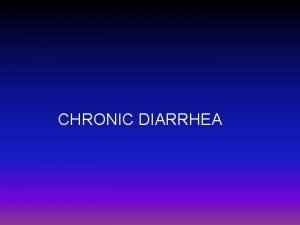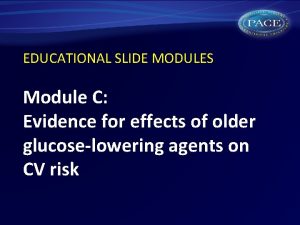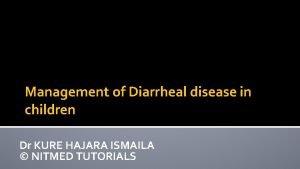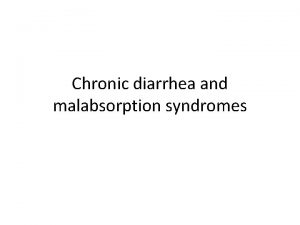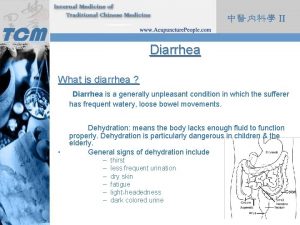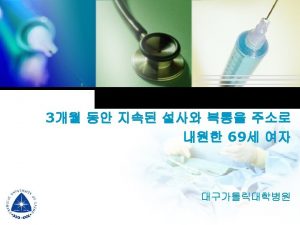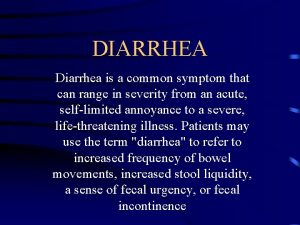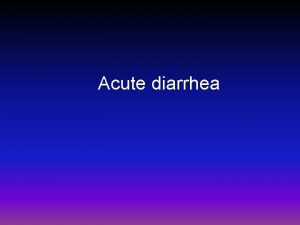Chronic Diarrhea Diarrhea is a major cause of











- Slides: 11

Chronic Diarrhea

• Diarrhea is a major cause of childhood morbidity and mortality worldwide. • Chronic diarrhea lasts more than 2 weeks and has a wide range of possible causes, including serious and benign conditions that are more difficult to diagnose. • Parents use the word diarrhea to describe loose or watery stools, excessively frequent stools, or stools that are large in volume. • Constipation with overflow incontinence can be mislabeled as diarrhea. • A more exact definition of diarrhea is excessive daily stool liquid volume (>10 m. L stool/kg body weight/day). • Stool texture, volume, and frequency help to characterize the episode of diarrhea.

Differential Diagnosis • Diarrhea may be classified by etiology or by physiological mechanisms (secretory or osmotic). • Etiological agents include viruses, bacteria or their toxins, chemicals, parasites, malabsorbed substances, and inflammation. • Secretory diarrhea occurs when the intestinal mucosa directly secretes fluid and electrolytes into the stool and is the result of inflammation (e. g. , IBD, chemical stimulus). • Secretion also is stimulated by mediators of inflammation and by various hormones, such as vasoactive intestinal peptide secreted by a neuroendocrine tumor. • Cholera is a secretory diarrhea stimulated by the enterotoxin of Vibrio cholerae, which causes increased levels of cyclic adenosine monophosphate (c. AMP) within enterocytes and leads to secretion into the small-bowel lumen.




• • Osmotic diarrhea occurs after malabsorption of an ingested substance, which “pulls” water into the bowel lumen. A classic example is the diarrhea of lactose intolerance. Osmotic diarrhea also can result from generalized maldigestion, such as that seen with pancreatic insufficiency or with intestinal injury. Certain nonabsorbable laxatives, such as polyethylene glycol and milk of magnesia, also cause osmotic diarrhea. Fermentation of malabsorbed substances (e. g. , lactose) often occurs, resulting in gas, cramps, and acidic stools. A common cause of chronic loose stools in early childhood is functional diarrhea, commonly known as toddler's diarrhea. This condition is defined by frequent watery stools in the setting of normal growth and weight gain and is caused by excessive intake of sweetened liquids overwhelming the disaccharide absorptive capacity of the intestine. Diarrhea typically improves tremendously when the child's beverage intake is reduced or changed.

Distinguishing Features • • • Stools are isosmotic, even in osmotic diarrhea, because of the relatively free exchange of water across the intestinal mucosa. Osmoles present in the stool are a mixture of electrolytes and other osmotically active solutes. To determine whether the diarrhea is osmotic or secretory, the osmotic gap is calculated: 290 - 2(Na +K) Assuming the stool is isosmotic (an osmolarity of 290 m. Osm/L), the measured stool sodium and potassium (and their associated anions, accounting for an equal amount) accounts for much of the osmolality. Secretory diarrhea is characterized by an osmotic gap of less than 50. A number significantly higher than 50 defines osmotic diarrhea and indicates that malabsorbed substances other than electrolytes account for fecal osmolarity.

• Another way to differentiate between osmotic and secretory diarrhea is to stop all feedings (in hospitalized patients receiving IV fluids). • If the diarrhea stops completely while the child is NPO (nothing by mouth), the patient has osmotic diarrhea. • A child with a pure secretory diarrhea would continue to have massive stool output. • Viral enteritis damages the intestinal lining, causing malabsorption and osmotic diarrhea. • The associated inflammation results in release of mediators that cause excessive secretion. • A child with viral enteritis may have decreased stool volume while NPO, but the secretory component of the diarrhea persists until the inflammation resolves.

• The history should include the onset of diarrhea, number and character of stools, estimates of stool volume, and presence of other symptoms, such as blood in the stool, fever, and weight loss. • Recent travel and exposures should be documented, dietary factors should be investigated, and a list of medications recently used should be obtained. • Factors that seem to worsen or improve the diarrhea should be determined. • Physical examination should be thorough, evaluating for abdominal distention, tenderness, quality of bowel sounds, presence of blood in the stool or a large fecal mass on rectal examination, and anal sphincter tone.

• Laboratory testing should include stool culture and complete blood count if bacterial enteritis is suspected. • If diarrhea occurs after a course of antibiotics, a Clostridium difficile toxin assay should be ordered • if stools are reported to be oily or fatty, fecal fat content or fecal elastase to test for pancreatic insufficiency should be measured. • Tests for specific diagnoses should be sent when appropriate (e. g. , serum antibody tests for celiac disease; colonoscopy for suspected ulcerative colitis). • A trial of lactose restriction for several days or lactose breath hydrogen testing is helpful in the evaluation of lactose intolerance.
 Causes of secretory diarrhea
Causes of secretory diarrhea Chronic diarrhea
Chronic diarrhea Metformin and constipation
Metformin and constipation Imprinting biology example
Imprinting biology example Underlying cause and immediate cause
Underlying cause and immediate cause Greylag goose egg-retrieval behavior
Greylag goose egg-retrieval behavior Ultimate and proximate causes of behaviour
Ultimate and proximate causes of behaviour What was the main cause of the punic wars?
What was the main cause of the punic wars? The life today is too fast demanding
The life today is too fast demanding Major cause of ww1
Major cause of ww1 Diarrhea introduction
Diarrhea introduction Diarrhea
Diarrhea
